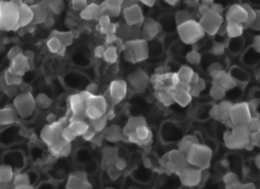Antibacterial properties of nanostructured Cu–TiO2 surfaces for dental implants
Abstract
The influence of copper derived TiO2 surfaces (nCu–nT-TiO2) on the death of nosocomial Staphylococcus aureus (Sa) and Escherichia coli (Ec), was investigated. TiO2 nanotube (nT-TiO2) arrays were fabricated by anodic oxidation of pure titanium sheets in fluorhydric solutions, leading to surface nanostructuration and creation of specific reactive sites. Copper nanocubes with a mean size of 20 nm have been synthesized and deposited on the nT-TiO2 surface by pulsed electrodeposition from a copper sulphate solution. Scanning Electron Microscopy (SEM) reveals that Cu nanocubes are both inserted into the TiO2 nanotubes and on the nanotube edges. X-ray Photoemission Spectroscopy (XPS) and SEM-EDX confirm the metallic nature of copper nanoparticles, covered with a thin mixed CuO–Cu2O thin layer. As the adsorption of proteins is one of the early stages of biomaterial surface interactions with body fluids before bacterial colonization, Infrared Spectroscopy (IR) in reflection–absorption mode, SEM and XPS have been used to follow the evolution of nCu–nT-TiO2 surfaces when exposed to a simulated plasma solution containing Bovine Serum Albumin (BSA). Finally bacterial tests have revealed a high biocide potential of the nCu–nT-TiO2 surface, which leads to the entire death of SA and EC.



 Please wait while we load your content...
Please wait while we load your content...